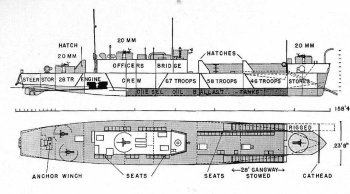![]() The Pacific War Online Encyclopedia
The Pacific War Online Encyclopedia
|
| Previous: LCC Class, Allied Landing Craft | Table of Contents | Next: LCM Class, Allied Landing Craft |
|
U.S. Army. Via Leighton and Coakley (1955) |
 ONI 226 |
|
Tonnage |
246 tons displacement |
|
Dimensions |
153' by 23'3" by 5'3" |
|
Maximum speed |
15 knots |
| Complement |
24 |
|
Armament |
Light antiaircraft
guns Early units carried two 300 lb (136 kg) depth charges |
| Protection |
2.75" (70mm) plastic armor
around conning station, wheelhouse, and gun positions |
| Machinery |
2-shaft GM diesel (1600 bhp) |
| Bunkerage |
110 tons |
| Range |
500 nautical miles (900 km)
at
15 knots 4000 nautical miles (7400 km) at 10 knots carrying extra fuel in place of troops and cargo |
|
Capacity |
250 troops |
| Variants |
Beginning with the Treasury
Islands landings
in
October 1943, a number of LCIs were modified as
LCI(G) with 2 20mm
Oerlikon
AA guns, 3 40mm
Bofors AA guns, and 5 0.50
machine guns. These ships had a larger complement but
little
troop-carrying capacity. A total of about 219 LCI were
converted to LCI(G) by the end of the war. By the time of the Marshalls
campaign, 24
LCI(G) had been equipped with an additional six rocket racks, each with
72 rockets. The rockets had a range of 1100 yards and the
modified craft were designated as LCI(R)s. |
The Landing Craft, Infantry,
Large or LCI(L)
(often referred to simply as the LCI or "Elsie Item") was a large
seagoing landing
craft used to land troops
and supplies on hostile beaches. The
design originated with British
requirements for a landing craft capable of crossing the English
Channel on its own power and landing a company
of raiders.
Because the British were already fully occupied constructing LCTs, they sought to have the craft
constructed in the United
States,
and requirements were transmitted to Washington, D.C., on 30 April
1942. By this time the British were beginning to recognize that
the
design they had in mind would be ideal for the cross-channel invasion of France, and they requested the
construction of 300 LCIs, enough to carry the 60,000 troops
projected
for a 1943 landing. However, for political reasons (chiefly a bid
to
gain sponsorship by the U.S. Army, which preferred small landing
craft
to large landing ships) the LCI continued to be characterized as a
raiding craft.
Because there was no shipping to spare to carry
the craft across the Atlantic, the LCI was required to have enough
range and seaworthiness to make the journey on its own power with
extra
fuel stowage. Its design landing slope (1:100) reflected its
anticipated use landing troops across the flat beaches of France,
and
sometimes proved problematic in the Pacific, where few beaches had
this
ideal slope. To achieve the desired speed of 15 knots or better,
the
LCI required two 4' (1.2m) propellers, large enough that the
propellers
required tunnel protection, which was provided by three skegs.
Variable-pitch propellers were used, to accommodate different
loadings,
a pioneering use of this propeller technology in the United
States. The
craft proved adept at beaching and retracting, but were very
unmaneuverable while backing.
Building capacity in the United States was already
very heavily subscribed, and construction was simplified by
designing
with as few curves as possible, resulting in a rather boxy craft.
Production began on 7 July 1942 and the first unit was completed
on 9
October 1942. The first LCIs entered combat in July 1943 at Kiriwina in
New Guinea and Kiska in the Aleutians. They
quickly
proved their worth here and at Sicily in the Mediterranean
Theater.
The LCI was equipped with two bow ramps that
allowed its passengers to
quickly disembark. Normal
armament was a
few light antiaircraft
guns, but a
number were specialized as fire support craft, LCI(G)s, with
heavier
antiaircraft
and
rocket launchers. The chief limitation of the LCI in the Pacific
was
its short
cruising range,
which meant it had to be loaded at a port
close to the planned
amphibious
operation. This reduced its strategic flexibility.
The Japanese had no real equivalent to the LCI, which was much larger than anything in the Japanese arsenal.
Though designated as craft, the LCI was clearly
more ship than craft, with its relatively large size and
oceangoing
capability. Their relatively high speed for a landing craft
contributed
to their popularity. As a result, it was redesignated the Landing
Ship,
Infantry, Large (LSIL) in 1946. There was also a Landing Craft,
Infantry, Small or LCI(S), the British GRC Mk II, which was
produced in
relatively small numbers and saw little or no use in the Far East.
The following table gives total production. About 30% of
this
was allocated to the Pacific until the final year of the war, when
most
of the amphibious fleet began to be shifted to the Pacific.
|
1942-9 |
1 |
|
1942-10 |
25 |
|
1942-11 |
59 |
| 1942-12 |
68 |
| 1943-1 |
70 |
| 1943-2 |
47 |
| 1943-3 |
22 |
| 1943-4 |
10 |
| 1943-5 |
3 |
| 1943-6 |
9 |
| 1943-7 |
16 |
| 1943-8 |
22 |
| 1943-9 |
23 |
| 1943-10 |
25 |
| 1943-11 |
28 |
| 1943-12 |
30 |
| 1944-1 |
35 |
| 1944-2 |
34 |
| 1944-3 |
54 |
| 1944-4 |
69 |
| 1944-5 |
78 |
| 1944-6 |
60 |
| 1944-7 |
44 |
| 1944-8 |
36 |
| 1944-9 |
27 |
| 1944-10 |
26 |
 |
 |
References
Clancey (2010-9-23; accessed 2011-1-12)
GlobalSecurity.org
(accessed
2009-7-29)
Leighton
and
Coakley (1955)
Morison
(1950, 1951)
The Pacific War Online Encyclopedia © 2007-2009, 2012, 2016 by Kent G. Budge. Index